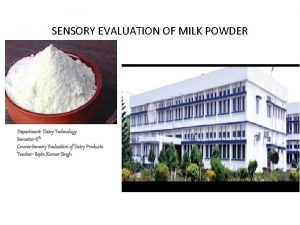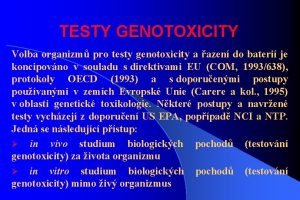Genotoxicity evaluation of natural products Mechanism of podophyllin


- Slides: 2


Genotoxicity evaluation of natural products : Mechanism of podophyllin induced genotoxicity and the chemical analysis of podophyllin n Herbal medicines have been used for more than thousands of years. The market sales increase gradually as the alternative medicine spring up. Herbal medicines are regulated as medicine in Taiwan. Due to the technology development, herbal medicines are taken not only the original type but also extracted powder or tablet prepared from herbal medicines, hence, the intake amounts by human are augmented, the past traditional experience of intake and the concept of safety is not suitable for modern herbal medicine application on human. It is necessary to reevaluate the toxicity from the constituents of herbal medicine commonly used. Among the possible mechanism of intoxication, genotoxicity is the newly developed toxicity field, and it draws human’s attention as well as is capable of conducting on the research till the nineteenth century. It’s a secret worry for lacking of detailed genotoxicty data from herbal medicine but considered as safety from the intake experience. As the understanding on mutagenicity of natural products is confined, thesis focuses on this field. The aim of thesis is to establish a low-cost and highly efficient screening mode, and applied to screen huge amounts of samples extensively, following the screening assay, the suspected mutagen is reconfirmed its genotoxic effect and then investigates on the genotoxicity mechanism. Genotoxic screening on thirty-six natural compounds have been finished in the past several years. Some of them are suspected as mutagens, hence, we extend the related researches on parts two and three. Shortly, thesis consists of three parts, Part I, First screening tests of the natural products, which is short of genotoxicity to support its safety are conducted by in vitro microbial genotoxicity (Ames Test). The chemicals by chemical structures classification include flavonoids, organic acids (phenols), coumarins, terpenoids, alkaloids and glycosides. The tested compound are as follows: allantoin, amygdalin, asarone, asiaticoside, baicalein, baicalin, caffeic acid, cinnamic acid, coumarin, costunolide, daidzein, digitoxin, 6, 7 -dimethoxycoumarin, ? ? -escin, ferulic acid, furolic acid, gentiopicroside, 18? ? -glycyrrhetic acid, hesperidine, imperatorine, isorhamnetin, kaempferol, naringin, neohesperidine, paeonol, podophyllin, podophyllotoxin, puerarin, quercetin, rutin, silymarin, silybin, strychnine, umbelliferone, wogonin and yohimbine. Salmonella typhrium Strains of TA 98, TA 100 and TA 102 were selected to perform the test, with and without the metabolic enzyme, observed the microbial mutagenicity. Quercetin and podophyllininduced revertants show concentration-response relationship, suggesting quercetin and podophyllin showed strong mutagenic effect potentially in the preliminary test. As podophyllin is easily obtained, the genotoxic activity needs to be cautioned. Hence, podophyllin was selected as the role in the part two. As a mixture of podophyllin, the true contributor for genotoxicity has not been defined; it needs to verify the constituents. The part two consists of two subjects, one describes the chemical analysis of podophyllin (Part II-A) and the other describes the investigation on genotoxic mechanism of podophyllin. An LC/MS/MS method was developed to analyze podophyllin. The identification of constituent was conducted on daughter ion scanning mode, and the determination was conducted on the multiple reacting monitoring mode. The quantitative results from LC/MS/MS show the percentage of podophyllotoxin, kaempferol and quercetin in podophyllin were 31. 2, 3. 2 and 1. 8%. Following the quantitative results, each constituent was used to evaluate the genotoxic potential in order to clarify the podophyllin-induced genotoxicity, whether the mutagenic effect is from known mutagenic effects of quercetin and kaempferol or not (Part II-B). The evaluation method for genotoxicity consists of microbial genotoxicty test and mammal chromosome aberration test in vitro as well as mammal micronucleus formation in vivo. Podophyllin showed positive reaction in Ames test, chromosome test and in vivo micronucleous test, but quercetin and kaempferol related to the contents in podophyllin used only showed genotoxicity in Ames test, especially, in the presence of metabolic activation systems in the strain TA 98, but not in chromosome test and in vivo micronucleous test. From the above result, quercetin and kaempferol-induced mutagenic effect were excluded. On the other hand, this finding indicates that another compounds existing in podophyllin induce genotoxicity, and than raises the doubt about the safety of podophyllin application. In order to investigate the genotoxic mechanism of podophyllin, reactive oxygen species (ROS) was also carried out. The ROS production assay showed that podophyllin increases the DCF fluorescenc in CHO cells, implying that ROS production was induced by podophyllin. The ROS production is accepted as related to genotoxicity. Different results are from three constituents by the same ROS assay. Quercetin or podophyllotoxin or kaempferol do not induce ROS production. The results showed that there is no relationship between podophyllin and its three separate components on the induction of ROS production by podophyllin Besides, podophyllotoxin, the major constituent of podophyllin, do not display in vitro genotoxicty, but show the increase on the incidence of micronucleus formation by concentrationdependently. Hence, we continuously investigate the pharmacological and toxicological properties of podophyllin. In the pharmacological study, podophyllin induced apoptosis, and resulted in G 2/M arrest by propidium iodide based on DNA analysis (cell cycle). Apoptosis represents DNA damage is from podophyllin, and DNA damage might be result in micronucleus formation or chromosome aberration. Among them, quercetin or kaempferol do not effect on cell cycle expression, but podophyllotoxin shows the same cell cycle modulating effects. We suggest that podophyllotoxin might be as a promutagen and induce gene mutation by the metabolism in vivo Collecting the above results, podophyllin, the commonly used herbal medicine, showed mutagenicty in the mutagenic screening work among thirty-six compounds, and the mutagenic effect is not from quercetin or kaempferol. We are unable to confirm that the podophyllin-induced genotoxicity is from podophyllotoxin even though which shows the increase on micronucleus formation, other constituents contribute the genotoxicity in vitro microbial mutagenicity study. We establish the genotoxic-screening mode for herbal medicine by the accomplishment of thesis. In addition to verify its mutagenicty, find more safe and alternative substances in advance. We wish the research could expend to other un-testing substances in order to protect the medication safety.



